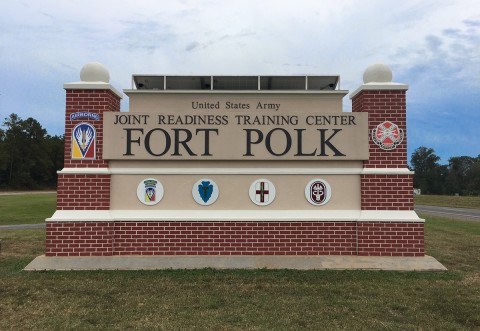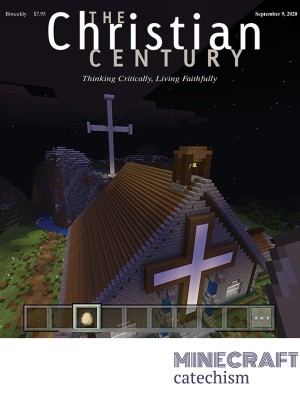Can offensive monuments from the past help hold us accountable today?
Perhaps the names once chosen for honor can now spark meaningful conversation.

This summer, there has been renewed conversation about the ten US military bases that are named after Confederate officers. This conversation follows a broader controversy over the past decade about the extent to which statues, monuments, building names, and the like should continue to pay homage to a time when the ownership of human beings as chattel was widely accepted. Questions have been raised about numerous institutions and leaders, from explorers to founding fathers to presidents, from churches to schools to military installations.
One of the military bases in question is Fort Polk, in Louisiana. Established as a training base during World War II, it is named after Confederate general Leonidas Polk, who was killed in battle in 1864—and who was also a bishop of the Episcopal Church.
Read our latest issue or browse back issues.
Before Polk, a leading founder of the University of the South (Sewanee), became bishop of Louisiana, he lived in Maury County, Tennessee, where people enslaved by his family erected a church that is still visited in pilgrimages. Records from 1840 suggest that Polk was the largest slaveholder in the county; he owned even more enslaved people after he moved to Louisiana.
In the face of consternation and rebuke from other bishops in both the North and the South, Polk ultimately chose to break away from the Episcopal Church, then called the Protestant Episcopal Church in the United States of America, and found the Protestant Episcopal Church in the Confederate States of America. He also chose to take up arms with the Confederacy.
As a clergyman, Polk was beloved. His record as a West Point-trained military commander, however, was less than stellar. Tactical errors attributed to him have been pointed to as the cause of some stunning Confederate losses. But he appears to have been highly regarded among the troops, and his death in combat was deeply mourned. A monument to Polk stands on the site where he was killed near Marietta, Georgia.
And despite Bishop Polk having broken away from the national church, he was remembered well as a priest and pastor, too. A marker in his memory is said to have been placed near the altar at St. Paul’s Church in Augusta, Georgia, the church where he was originally interred. (In 1945, his remains were taken back to the Diocese of Louisiana and reinterred in the sanctuary of Christ Church Cathedral in New Orleans.) As far away as Cincinnati, a plaque in memory of Polk was hung in Christ Church Cathedral, where he was originally consecrated as a missionary bishop.
The recent conversation about these ten military installations presents us with two specific opportunities. First, it invites us to examine the decisions by the United States armed forces to honor officers who fought against the US, along with the timing of those decisions: of the ten bases, only one was established before World War I. Half were established during World War II, 75 years after the Civil War. All were established during the Jim Crow era of segregation.
A second opportunity, particularly in the case of Fort Polk and the man after whom it was named, is for a critical consideration of the role of the church and the clergy in the institution of slavery—their silence and in some cases complicity in the project of viewing some human beings, made in the image and likeness of God, as being less than and unentitled to the very liberties upon which this nation was founded.
As a Christian minister and an African American woman, I try to place the question of what we choose to honor within the context of what we read in scripture. Our forebears in the faith were not perfect people—yet we learn much about ourselves from the critical study of their lives.
Abraham takes the enslaved woman Hagar and their son Ishmael into the wilderness and leaves them, presumably to die. Despite Abraham’s shortcomings and failures, we still recognize God’s faithfulness to him in remaining in covenantal relationship. Joseph’s brothers sell him into slavery; this initiates the sojourn of the people called Israel into Egypt, which likely saves them from famine and leads in turn to them finally gaining a place in which Abraham’s descendants can grow to be as many as the stars in the sky—and God’s covenant with Abraham can be fulfilled. We celebrate the reign of the great king David, even as we reflect upon the upbraiding that Nathan gives him after David has Uriah killed and takes Bathsheba for himself—even as we recognize just how many commandments a very human David has broken in this episode.
While reading these scriptural accounts may make us cringe, these are not texts to avoid. Studying them invites us to critical reflection—not to judge our forebears under our modern microscope but rather to ask ourselves questions, to examine our own existence and humanity, and to seek to discern how God might call us to live differently. When have we, too, displaced those in our own lives and communities who are no longer useful to us? When have we, too, been willing to trade the life of a sister or brother made in the image and likeness of God for a few pieces of silver?
While studying the shared history of our 400 years on this soil may make us cringe, this is not history to avoid, either. It too should invite us to question ourselves, examine our humanity, and discern God’s call to live differently. As tempting as it may be to remove or rename the vestiges of our segregated past, I think we need to approach such a process with great care and deliberation. We need to make sure we are all well educated in the facts we might seek to erase.
It’s imperative that we expound upon the half-truths told, study the fuller explanation that history provides, learn from the lives of these historical figures, and ask ourselves how we might live more faithfully in our own time. If all offensive monuments were erased from our public memory, what would hold us accountable to one another to engage in honest, critical conversation about our history—and to experience the kind of healing and transformation that our communities need?
What might happen if, instead of renaming the Edmund Pettus Bridge in Selma, Alabama, we added a statue of Congressman John Lewis at the bridge site? It could include a marker that bears the infamous image of Lewis being beaten by state troopers nearby, along with a sign inviting people to cross the street to the Voting Rights Museum, where they can learn more about the history of that community and the fight for voting rights in Alabama in 1965.
If the vestiges of our segregated past serve no other purpose, perhaps they can unite us in recalling that the promises of liberty upon which this country was founded have not been kept for all people—and mobilize us to seek justice for every person made in the image and likeness of God. Perhaps that sort of transformation can only come from the kind of honest dialogue that the church and the nation seem to have worked hard to avoid.
A version of this article appears in the print edition under the title “Names from the past.”





